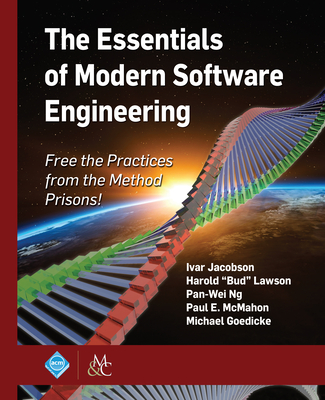The Essentials of Modern Software Engineering: Free the Practices from the Method Prisons!
暫譯: 現代軟體工程的基本要素:解放實踐於方法的監獄!
Jacobson, Ivar, Lawson, Harold Bud, Ng, Pan-Wei
- 出版商: Macmillan
- 出版日期: 2019-07-19
- 售價: $2,720
- 貴賓價: 9.5 折 $2,584
- 語言: 英文
- 頁數: 399
- 裝訂: Quality Paper - also called trade paper
- ISBN: 1947487248
- ISBN-13: 9781947487246
-
相關分類:
Agile Software
海外代購書籍(需單獨結帳)
買這商品的人也買了...
-
 Soft Skills: The software developer's life manual (Paperback)
Soft Skills: The software developer's life manual (Paperback)$1,350$1,283 -
 $414DevOps 實踐 (Practical DevOps)
$414DevOps 實踐 (Practical DevOps) -
 $234輕量級 Django
$234輕量級 Django -
 $330超越需求敏捷思維模式下的分析 (Beyond Requirements: Analysis with an Agile Mindset)
$330超越需求敏捷思維模式下的分析 (Beyond Requirements: Analysis with an Agile Mindset) -
 軟體專案開發實務|別只當編程猴 (Programming Beyond Practices: Be More Than Just a Code Monkey)
軟體專案開發實務|別只當編程猴 (Programming Beyond Practices: Be More Than Just a Code Monkey)$400$316 -
 $330修改軟件的藝術 : 構建易維護代碼的 9條最佳實踐 (Beyond Legacy Code: Nine Practices to Extend the Life (and Value) of Your Software)
$330修改軟件的藝術 : 構建易維護代碼的 9條最佳實踐 (Beyond Legacy Code: Nine Practices to Extend the Life (and Value) of Your Software) -
 $297Python 新手學 Django 2.0 架站的 16堂課, 2/e
$297Python 新手學 Django 2.0 架站的 16堂課, 2/e -
 $505Kotlin 編程權威指南
$505Kotlin 編程權威指南 -
 管理技術債 (Managing Technical Debt)
管理技術債 (Managing Technical Debt)$520$442 -
 $236Python Web 開發基礎教程 (Django版)(微課版)
$236Python Web 開發基礎教程 (Django版)(微課版) -
 我們的行為是怎樣被設計的:友善設計如何改變人類的娛樂、生活與工作方式
我們的行為是怎樣被設計的:友善設計如何改變人類的娛樂、生活與工作方式$500$425 -
 Jetpack Compose 從入門到實戰
Jetpack Compose 從入門到實戰$654$621 -
 Code That Fits in Your Head|軟體工程的啟發式方法
Code That Fits in Your Head|軟體工程的啟發式方法$580$458
相關主題
商品描述
The first course in software engineering is the most critical. Education must start from an understanding of the heart of software development, from familiar ground that is common to all software development endeavors.
This book is an in-depth introduction to software engineering that uses a systematic, universal kernel to teach the essential elements of all software engineering methods.
This kernel, Essence, is a vocabulary for defining methods and practices. Essence was envisioned and originally created by Ivar Jacobson and his colleagues, developed by Software Engineering Method and Theory (SEMAT) and approved by The Object Management Group (OMG) as a standard in 2014. Essence is a practice-independent framework for thinking and reasoning about the practices we have and the practices we need. Essence establishes a shared and standard understanding of what is at the heart of software development. Essence is agnostic to any particular method, lifecycle independent, programming language independent, concise, scalable, extensible, and formally specified. Essence frees the practices from their method prisons.
The first part of the book describes Essence, the essential elements to work with, the essential things to do and the essential competencies you need when developing software. The other three parts describe more and more advanced use cases of Essence. Using real but manageable examples, it covers the fundamentals of Essence and the innovative use of serious games to support software engineering. It also explains how current practices such as user stories, use cases, Scrum, and micro-services can be described using Essence, and illustrates how their activities can be represented using the Essence notions of cards and checklists. The fourth part of the book offers a vision how Essence can be scaled to support large, complex systems engineering.
Essence is supported by an ecosystem developed and maintained by a community of experienced people worldwide. From this ecosystem, professors and students can select what they need and create their own way of working, thus learning how to create ONE way of working that matches the particular situation and needs.
商品描述(中文翻譯)
軟體工程的第一門課程是最關鍵的。教育必須從理解軟體開發的核心開始,從所有軟體開發工作中共同的熟悉領域著手。
本書是對軟體工程的深入介紹,使用一個系統性的、普遍的核心來教授所有軟體工程方法的基本要素。
這個核心,Essence,是一種用於定義方法和實踐的詞彙。Essence 是由 Ivar Jacobson 和他的同事們構思並最初創建的,經由軟體工程方法與理論(SEMAT)發展,並於 2014 年獲得物件管理組織(OMG)的標準認可。Essence 是一個與實踐無關的框架,用於思考和推理我們擁有的實踐和我們需要的實踐。Essence 建立了對軟體開發核心的共同和標準理解。Essence 對任何特定方法都是中立的,與生命週期無關,與程式語言無關,簡潔、可擴展、可延伸,並且有正式的規範。 Essence 使實踐擺脫了方法的束縛。
本書的第一部分描述了 Essence、需要處理的基本要素、開發軟體時需要做的基本事項以及所需的基本能力。其他三部分則描述了 Essence 的越來越高級的使用案例。使用真實但可管理的範例,涵蓋了 Essence 的基本原則以及創新使用嚴肅遊戲來支持軟體工程。它還解釋了如何使用 Essence 描述當前的實踐,如用戶故事、用例、Scrum 和微服務,並說明如何使用 Essence 的卡片和檢查清單概念來表示它們的活動。本書的第四部分提供了一個願景,說明如何擴展 Essence 以支持大型、複雜的系統工程。
Essence 得到了由全球經驗豐富的社群開發和維護的生態系統的支持。在這個生態系統中,教授和學生可以選擇他們所需的內容,並創建自己的工作方式,從而學習如何創建一種符合特定情況和需求的工作方式。












